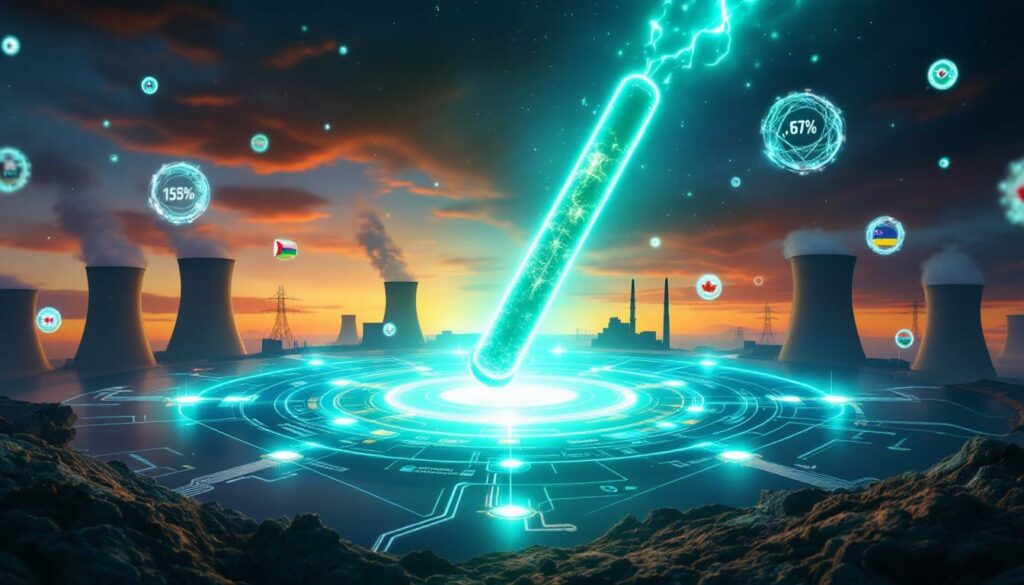What Makes Uranium a Unique Investment Opportunity?
Uranium stands apart in the commodities landscape as a specialized investment with distinctive market dynamics that create compelling opportunities for investors. Unlike more mainstream commodities such as gold or copper, uranium operates in a market with limited participants, specialized applications, and unique supply-demand fundamentals.
The nuclear fuel market presents a strategic uranium investment case based on structural imbalances that appear poised to drive price appreciation over the coming years.
The Current Supply-Demand Imbalance
The global uranium market currently faces a significant structural deficit that underpins the investment thesis. Annual production stands at approximately 165 million pounds, while demand reaches 180 million pounds – creating a substantial 15 million pound annual shortfall that must be filled from secondary sources.
This deficit has been developing for years as uranium prices remained depressed following the 2011 Fukushima incident, leading to mine closures and project deferrals. The production gap cannot be quickly resolved due to the lengthy timelines required to develop new uranium projects.
"Supply and demand fundamentals suggest that the uranium price has to increase substantially… it's very hard to bring on new supply in time to meet the ever-increasing demand." — Andre Liebenberg, CEO of Yellow Cake PLC
Price Movement Potential
Uranium prices have demonstrated remarkable uranium market volatility and upward momentum in recent years. From market lows of approximately $21 per pound during the bottom of the cycle, prices have climbed to around $76 per pound by mid-2025, representing a more than 250% increase.
Despite this impressive rise, many industry analysts and market participants believe this represents only the early stages of a longer-term bull market. The price movement reflects a fundamental rebalancing as years of underinvestment in production capacity collide with growing demand.
Historical uranium price movements typically follow multi-year cycles characterized by:
- Extended periods of price depression that lead to supply destruction
- Rapid price acceleration when market imbalances become acute
- Price overshoots as utilities scramble to secure supplies
- Gradual supply responses that eventually moderate prices
Investment Vehicles for Uranium Exposure
Investors seeking exposure to the uranium market have several options, each with distinct risk-reward profiles:
Physical uranium holding companies
- Examples include Yellow Cake PLC, which holds approximately 22 million pounds of physical uranium stored in secure facilities in Canada and France
- Provide direct exposure to uranium price movements without operational mining risks
- Typically trade at a premium or discount to their Net Asset Value (NAV)
Uranium mining equities
- Offer operational leverage to uranium prices
- Range from large, diversified producers to exploration-stage companies
- Include major producers like Cameco and Kazatomprom, as well as developers and explorers
- Carry specific company risks related to operations, jurisdictions, and management
ETFs focused on the nuclear fuel cycle
- Provide diversified exposure across multiple uranium-related companies
- Typically include a mix of miners, developers, and uranium-adjacent businesses
- Offer simplified access for retail investors without requiring individual stock selection
Futures contracts
- Allow direct speculation on uranium prices
- Generally feature limited liquidity and are primarily used by industry participants
- Require specialized brokerage accounts and understanding of futures markets
How Does the Global Uranium Supply Chain Function?
The uranium supply chain represents a complex, multi-stage process that transforms raw uranium ore into nuclear fuel for reactors. Understanding this supply chain reveals critical bottlenecks and strategic considerations that directly impact investment opportunities.
Major Production Sources and Concentration Risk
The global uranium production landscape is characterized by extreme concentration, with approximately 90% of worldwide production coming from just five countries. This concentration creates significant geopolitical risks and potential supply vulnerabilities:
Kazakhstan dominates global production, accounting for approximately 40% of worldwide uranium output. The Central Asian nation has become the Saudi Arabia of uranium, with its production heavily influencing global supply dynamics. Notably, Kazakhstan routes approximately 50% of its production to China, highlighting the growing bifurcation between Eastern and Western supply chains.
Canada remains a significant producer with some of the world's highest-grade uranium deposits, particularly in the Athabasca Basin. Canadian production is centered around a small number of exceptionally high-grade mines operated primarily by Cameco.
Namibia has emerged as a growing uranium supplier, though with notable Chinese ownership of key assets. The African nation hosts several major development projects that could meaningfully impact global supply if brought online. Recent Namibia uranium mining halt announcements have further tightened supply expectations.
Australia possesses substantial uranium resources but currently has limited production from a single major mine. The country maintains significant potential for expanded production if market conditions warrant.
Uzbekistan rounds out the top five producers, representing a smaller but significant source of uranium production.
This geographic concentration creates considerable supply risk, as disruptions in any single major producing country – particularly Kazakhstan – could have outsized impacts on the global market.
The Conversion and Enrichment Bottlenecks
Beyond mining, the nuclear fuel cycle includes critical processing steps that represent significant bottlenecks in the uranium supply chain:
-
Conversion: Raw uranium oxide (U₃O₈) must be converted to uranium hexafluoride (UF₆) before enrichment can occur. This process takes place at specialized facilities with limited global capacity.
-
Enrichment: Natural uranium contains approximately 0.7% uranium-235, which must be increased to 3-5% for conventional reactor fuel through a complex enrichment process.
These intermediate steps in the fuel cycle represent critical choke points with:
- Limited global capacity concentrated in few facilities
- High technical barriers to entry
- Significant capital requirements for new facilities
- Long lead times for capacity expansion
"Conversion is a pinch point in the fuel cycle… There's not sufficient conversion capacity available globally to meet current demand." — Andre Liebenberg
Conversion prices have experienced extreme volatility, ranging from approximately $20 to $90 per kilogram in recent years, highlighting the supply constraints in this segment of the fuel cycle.
Secondary Supply Limitations
Secondary supplies have historically filled gaps between primary production and demand, but these sources are diminishing:
Underfeeding occurs when enrichment facilities extract additional uranium from the enrichment process by operating more efficiently. This practice depends on excess enrichment capacity, which has declined significantly in recent years.
Inventory drawdowns from utility stockpiles have helped bridge supply gaps, but these reserves are approaching critical levels. U.S. utilities now hold approximately two years of coverage – approaching minimum operational requirements given the 18-24 month nuclear fuel cycle.
Government stockpile releases have historically provided additional supply, particularly from programs like the U.S.-Russia HEU Agreement (Megatons to Megawatts). However, most of these programs have concluded, removing a significant secondary supply source.
The depletion of these secondary sources increases pressure on primary production to meet growing demand, creating a fundamental driver for higher uranium prices.
Why Is New Uranium Supply Difficult to Develop?
The uranium market faces substantial challenges in bringing new production online to meet growing demand, creating a structural supply bottleneck that underpins the investment thesis. Unlike many commodities that can rapidly respond to price signals, uranium projects face uniquely lengthy development timelines and significant hurdles.
Lengthy Development Timelines
New uranium projects require extended periods to move from exploration to production:
Permitting processes typically take 3-5 years due to the regulatory complexities surrounding uranium mining. These processes involve multiple governmental agencies, environmental assessments, and public consultations that create significant timeline uncertainty.
Construction periods generally span 2-3 years once permitting is complete, with extensive infrastructure requirements including specialized processing facilities to handle radioactive materials.
Ramp-up phases of 1-2 years are needed to achieve nameplate capacity as operations are gradually optimized and production challenges addressed.
This creates a minimum 5-10 year lag between price signals and meaningful new production – a critical factor that often leads to extended price cycles in uranium markets. Even when uranium prices rise substantially, the supply response is necessarily delayed.
Capital Intensity and Investment Hurdles
Developing new uranium mines requires substantial capital commitments under challenging conditions:
- Major projects typically need $500+ million in investment, representing significant capital allocation decisions
- Financing depends on securing long-term contracts at economically viable prices
- Current term prices (approximately $80/lb) remain below the incentive price needed for many projects
- Project economics must account for potential price volatility over multi-decade mine lives
The combination of high capital requirements and uncertain long-term pricing creates significant hurdles for investment decisions, particularly for public companies answerable to shareholders focused on near-term returns.
Case Study: Namibian Development Projects
Two advanced uranium projects in Namibia illustrate the current market dynamics and development challenges:
Both projects require approximately $500 million in capital investment to reach production, representing significant financial commitments that depend on favorable uranium market conditions.
Development timelines extend 3-4 years from investment decision to initial production, highlighting the lag between price signals and supply response.
Recent investment decision delays by Deep Yellow suggest that current term prices of $80/lb remain insufficient to incentivize new capacity – indicating that higher sustained prices are needed to stimulate meaningful supply growth.
"Deep Yellow recently pushed back its final investment decision… suggesting $80/lb isn't high enough to incentivize new capacity." — Andre Liebenberg
This dynamic creates a potential catch-22 for the uranium market: prices need to rise to stimulate new supply, but the resulting production delays may lead to more extreme price movements before equilibrium can be reached.
How Is Uranium Demand Evolving?
The demand side of the uranium market is undergoing significant transformation, with several powerful forces converging to drive substantial growth. After years of stagnation following the Fukushima accident in 2011, nuclear power is experiencing a renaissance that has profound implications for uranium demand.
Nuclear Power Renaissance
After a decade of limited growth, nuclear power is experiencing renewed global interest driven by several compelling factors:
Climate change imperatives have positioned nuclear power as an essential component of decarbonization strategies. As a zero-carbon electricity source capable of providing reliable baseload power, nuclear energy offers a solution that complements intermittent renewable sources.
Energy security priorities have gained prominence following recent geopolitical disruptions, particularly in Europe. The ability to generate significant electricity from relatively small amounts of fuel that can be stockpiled has renewed appreciation for nuclear's strategic value.
Cross-party political support is emerging in previously nuclear-skeptical regions, with countries like Sweden, Belgium, and Japan reversing or reconsidering nuclear phase-out policies. This political realignment reflects pragmatic recognition of nuclear's role in addressing energy challenges.
The combination of these factors has created a more favorable environment for nuclear power development globally, with existing plants receiving life extensions and new construction gaining momentum.
The Data Center Revolution
The explosion of artificial intelligence and cloud computing is creating unprecedented electricity demand that is reshaping energy markets:
- Major tech companies are announcing multi-billion dollar data center investments, with Amazon alone investing $20 billion – equivalent to approximately 50% of the entire uranium sector's market capitalization
- The energy intensity of AI applications is driving exponential growth in power requirements
- Tech sector leaders increasingly view nuclear as essential for reliable, carbon-free electricity to power data centers
- This demand surge is occurring alongside broader electrification trends in transportation and industry
The scale of this emerging demand cannot be underestimated – data centers alone could require electricity equivalent to multiple countries' total consumption, creating competition for limited zero-carbon electricity sources.
Regional Growth Patterns
Nuclear growth varies significantly by region, creating a complex global demand picture:
China leads global expansion with 26-28 reactors currently under construction – more than the rest of the world combined. The country's commitment to nuclear power reflects both climate goals and energy security priorities, with ambitious targets for future growth.
The Middle East is emerging as a new nuclear market, with the UAE bringing its first reactors online and Saudi Arabia advancing plans for a substantial nuclear program. The region's move toward nuclear reflects diversification from fossil fuels and growing electricity demands.
Europe is reconsidering nuclear after energy security challenges, with countries like France recommitting to nuclear expansion, Poland advancing its first nuclear program, and the UK supporting both large-scale reactors and SMR development.
North America is focusing on extending its existing fleet through subsequent license renewals while developing Small Modular Reactor technology. The US ISR uranium production methods are also gaining traction, while the recent US uranium import ban on Russian material has further reshaped market dynamics.
This regionally diverse growth creates resilience in uranium demand, with different markets operating on distinct timelines and responding to various drivers.
What Drives Uranium Price Formation?
Understanding uranium price dynamics requires examining the market's unique structure, which differs substantially from other commodity markets. The uranium market operates with distinct mechanisms that create price formation patterns unlike those seen in more liquid commodities like oil or copper.
Spot vs. Term Markets
The uranium market operates with two distinct pricing mechanisms that serve different purposes and often move independently:
The spot market represents transactions for immediate or near-term delivery, accounting for approximately 15-20% of total uranium transactions. This market is:
- Highly volatile with significant price swings
- Thinly traded with limited liquidity
- Sensitive to relatively small trading volumes
- Subject to influence from financial investors
Recent price action has shown extraordinary volatility in spot prices, which fluctuated between $64-107 per pound before settling around $76 per pound in mid-2025.
The term market represents long-term contracts between producers and utilities, typically spanning 3-10 years. This market:
- Accounts for 80-85% of actual uranium transactions
- Demonstrates greater price stability
- More accurately reflects industry economics
- Provides the price signals that drive investment decisions
Term prices have stabilized around $80 per pound in 2025, creating a more reliable benchmark for industry participants despite spot market volatility.
This dual market structure creates opportunities for sophisticated investors who understand the relationship between spot and term prices, as well as the catalysts that drive convergence or divergence between the two.
Utility Contracting Cycles
Utility contracting behavior heavily influences market dynamics and creates cyclical patterns:
- Utilities typically maintain 3-5 years of forward coverage through term contracts
- Historical patterns show periods of contracting below consumption levels, followed by aggressive recontracting when coverage falls
- Current uncovered requirements are growing as older contracts expire, creating potential for a significant contracting cycle
- Utilities face competing pressure to secure supplies while avoiding paying cycle peak prices
"Utilities have contracted below usage for almost a decade… Inventories are declining globally." — Andre Liebenberg
This contracting behavior tends to amplify price cycles, as utilities collectively delay purchases during weak markets, then rush to secure supplies when market conditions tighten, often creating bidding wars for limited available material.
Investment Fund Impact
Financial investors have emerged as significant market participants, creating additional complexity in price formation:
- Physical holding vehicles like Yellow Cake PLC have purchased substantial uranium volumes
- A recent $200 million capital raise by one fund moved spot prices approximately $7/lb, demonstrating the impact of financial flows
- Investment demand creates additional pressure on limited spot supplies
- Financial investors can accelerate price movements in both directions
The uranium market's relatively small size – with a total sector market capitalization of approximately $40 billion – makes it particularly susceptible to financial flows that might be inconsequential in larger commodity markets.
This financial participation adds volatility but also provides liquidity and can accelerate price discovery, particularly when fundamental supply-demand imbalances exist.
What Are the Key Investment Considerations for Uranium?
Investors approaching the uranium sector should consider several critical factors that influence risk-reward profiles and investment outcomes. The uranium market presents unique characteristics that require specialized understanding and strategic positioning.
Timing Challenges
The uranium market presents distinctive timing considerations that can significantly impact investment returns:
Long-term fundamentals appear compelling based on the structural supply-demand imbalance and limited new production capacity. The case for higher uranium prices over a multi-year timeframe is supported by basic market economics.
Short-term catalysts can be difficult to predict, creating uncertainty around timing. Price movements in uranium can be irregular and subject to unexpected influences from policy changes, utility buying patterns, or supply disruptions.
Significant price volatility creates entry point challenges, with spot prices fluctuating by more than 60% within relatively short timeframes. This volatility can create both opportunities and risks for investors attempting to time market entry.
The optimal approach often involves positioning for the long-term fundamental case while remaining aware that near-term price movements may not reflect underlying fundamentals. Investors must balance conviction in the long-term thesis with the potential for extended periods of price consolidation.
Geopolitical Risk Assessment
Geopolitical factors heavily influence the uranium market, creating both risks and opportunities:
Growing bifurcation between Western and Eastern supply chains is creating two distinct uranium markets. Kazakhstan, which produces 40% of global uranium, sends approximately 50% of its output to China, highlighting this separation.
Western utilities face growing competition for limited supplies as China aggressively secures resources through long-term contracts and direct investment in production assets.
Resource nationalism is emerging in some jurisdictions as countries recognize uranium's strategic importance, potentially
Want to Capitalise on the Next Major Mineral Discovery?
Stay ahead of the market with Discovery Alert's proprietary Discovery IQ model, which instantly identifies significant ASX mineral discoveries and transforms complex data into actionable investment insights. Explore why historic discoveries have generated substantial returns by visiting the dedicated discoveries page and begin your 30-day free trial today.




